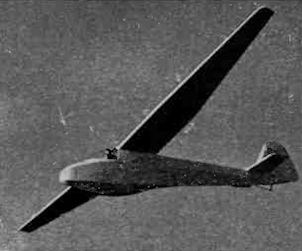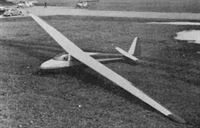
Варианты
- Scheibe - Spatz / SF-26 Super Spatz - 1952 - Германия
- Scheibe - SF-24 Motorspatz - 1960 - Германия
M.Hardy. Gliders & Sailplanes of the world
Scheibe L-Spatz-lll
Second of the postwar Scheibe designs to go into production was the Spatz (or Sparrow) single-seater suitable for training or competition flying; this first flew on 12 March 1952 and in its initial form was a mid-wing monoplane. It was developed into the high wing Spatz-55 and L-Spatz-55, the latter differing from the Spatz-55 mainly in having a wing span increased to 15m (49 ft 2 1/2 in) to give a 10% improvement in performance; the Spatz had the usual Scheibe construction of fabric-covered steel tube fuselage and a wooden single-spar wing, which on the L-Spatz-55 had an area of 125.9sq ft and an aspect ratio of 19.0. Next variant was the L-Spatz-lll, which differed from the 55 version in having aerodynamic twist on the outer wings to improve the stalling characteristics, larger air brakes and tail surfaces, a shallower fuselage to improve the aerodynamics and appearance, a roomier cockpit and a Flettner trim tab in the elevators. The wing leading edge torsion box is plywood-covered, the remainder of the wing being fabric-covered. The fuselage is rectangular in section forward and of triangular section at the rear, the rear fuselage having fabric covering over wooden formers. The nose is covered with a moulded glassfibre shell on the L-Spatz-lll, and the cantilever tail unit is of wood. The landing gear normally consists of a monowheel and nose skid, but a longer skid can be fitted under the fuselage and a detachable ground handling trolley can replace the monowheel. The pilot sits under a one-piece blown Plexiglas canopy, and has adjustable rudder pedals.
The L-Spatz-55 was also built under licence in small numbers at Monfalcone by the Italian firm of Meteor SpA Costruzioni Aeronautiche, as the MS 30L Passero (or Sparrow), and in France by Societe Avialsa as the Fauconnet A-60 (or Falconet). The latter was a refined version of the L-Spatz-55 which first flew in prototype form in June 1960 and received its French C of A in 1961; it was produced at the rate of two or three a month both in standard form and in a special version with 'super finished' wings, and was also made available in kit form for amateur constructors, requiring only about 400 hours of work to assemble. The special 'super finished' version had a better best glide ratio (29.5:1) and minimum sinking speed (2.03 ft/sec) than the standard one. A few L-Spatz-llls were also built under licence by the Spanish firm Stark Iberica SA.
Data: L-Spatz-lll
Span: 49 ft 2 1/2 in
Length: 20 ft 6 in
Height: 3 ft 11 in
Wing area: 125.9 sqft
Aspect ratio: 19.0
Empty weight: 353 lb
Max weight: 585 lb
Max speed: 112 mph
Max aero-tow speed: 78 mph
Min sinking speed: 2.20 ft/sec at 38.5 mph
Best glide ratio: 28:1
Scheibe Sperber
The third postwar design of Scheibe-Flugzeugbau GmbH, following the Mu-13E Bergfalke and the Spatz, was the Specht (or Woodpecker) tandem two seater training glider, which was completed in prototype form in March 1953. This featured the usual Scheibe construction of fabric-covered steel tube fuselage and two-spar braced wooden wings, which had a span of 44ft 3 1/2 in and an aspect ratio of 11. The Specht was developed into the Sperber (or Sparrowhawk), also a two-seat trainer but with enclosed side-by-side instead of tandem seating, and this first flew on 7 March 1956, later going into small-scale production. It also had a fabric-covered steel tube fuselage and braced fabric-covered wooden wings of 14% Mu section. The landing gear consists of a fixed monowheel and a spring steel tailskid.
Span: 46 ft 7 in
Length: 24 ft 3 in
Height: 4 ft 7 in
Wing area: 187.3 sq ft
Aspect ratio: 11.6
Empty weight: 485 lb
Max weight: 882 lb
Max speed: 106 mph
Min sinking speed: 3.05 ft/sec
Best glide ratio: 19:1
- M.Hardy. Gliders & Sailplanes of the world
Фотографии
-
Jane's All the World Aircraft 1964 / 03 - Sailplanes
L-Spatz-55 lightweight single-seat sailplane
-
GL 1982- / M.Hardy - Gliders and Sailplanes /Gliders & Sailplanes of the world/ (1)
Регистрационный номер: HB-575 Scheibe L-Spatz-55.
-
Jane's All the World Aircraft 1972 / 03 - Sailplanes
Регистрационный номер: D-1857 Scheibe L-Spatz-III lightweight single-seat sailplane
-
Jane's All the World Aircraft 1964 / 03 - Sailplanes
Регистрационный номер: F-CAMC [2] Avialsa Fauconnet, a licence-built version of the Scheibe L-Spatz-55
-
Jane's All the World Aircraft 1966 / 05 - Sailplanes
Регистрационный номер: F-CAMC [2] Avialsa Fauconnet, a licence-built version of the Scheibe L-Spatz-55
-
Air-Britain Archive 1982-04
Регистрационный номер: OO-ZIL Scheibe L-Spatz 55 OO-ZIL (C of R no.1377) has at some stage been fitted with a pylon-mounted motor.
-
Jane's All the World Aircraft 1964 / 03 - Sailplanes
Scheibe SF-26 Standard single-seat high-performance sailplane
-
Jane's All the World Aircraft 1966 / 05 - Sailplanes
Kit of parts for construction of the Avialsa Fauconnet A-60
- Фотографии







